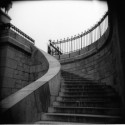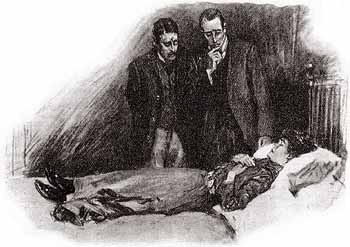A Scion Society of The Baker Street Irregulars

The 17 Steps: The Devil’s Foot
Seventeen thoughts for further ponderance of the case at hand – The Devil’s Foot (DEVI)

“GIVE ME BACK THAT PEN, HOLMES!”
Watson begins this tale with: “In recording from time to time some of the curious experiences and interesting recollections which I associate with my long and intimate friendship with Mr. Sherlock Holmes, I have continually been faced by difficulties caused by his own aversion to publicity.”
Why would Holmes give Watson problems just “recording” his cases, when at times, Watson almost seemed to be recording for Holmes himself? Wouldn’t the publishing be what Holmes gave him problems with?
Did Holmes always have an aversion to publicity, or was that just something that came along after The Strand Magazine tales?
THE WATSONIAN DROUGHT
“It was indeed this attitude upon the part of my friend and certainly not any lack of interesting material which has caused me of late years to lay very few of my records before the public.”
Let’s see: four in 1903, nine in 1904, two in 1908, and then Devil’s Foot in December 1910. Holmes’s attitude doesn’t seem to give Watson problems in these “late years” until Holmes is in Sussex. Why should the detective care when he’s off in the country where no one can find him?
THE UNFATHOMABLE MIND OF HOLMES
“I have no idea what backward sweep of memory had brought the matter fresh to his mind, or what freak had caused him to desire that I should recount it …” Watson writes.
Ah, but he’s just good old Watson. Surely the deductive powers of one of my fellow Hounds can solve the mystery of why Holmes went for DEVI in 1910. Any speculations? Why the words “Why not tell them …” like Watson will know just what “them” Holmes is speaking of after two years without publishing?
BEEN READING TOO MUCH CLARK RUSSELL, WATSON?
Watson gives us a mini-tale in his description of Mounts Bay, “with its fringe of black cliffs and surge-swept reefs on which innumerable seamen have met their end. With a northerly breeze it lies placid and sheltered, inviting the storm-tossed craft to tack into it for rest and protection.
“Then come the sudden swirl round of the wind, the blustering gale from the south-west, the dragging anchor, the lee shore, and the last battle in the creaming breakers. The wise mariner stands far out from that evil place.”
How does Watson know so much of the sea? Is this totally based upon reading sea stories, pub crawls with Cornwall seamen, or what?
THE UNITED NATIONS OF CORNWALL
Watson also writes of Cornwall’s “sinister atmosphere of forgotten nations.” How many nations and peoples preceded Holmes and Watson to this rocky shore? How many periods are represented in the earthworks, the burial mounds, the old world village remnants, and other stone monuments Watson writes of?
NOT-SO-GOOD OLD WATSON!
While we’ve come to think of Watson as the charming friend of friends, the Vicar Roundhay might disagree. Upon meeting him, Watson “glared at the intrusive vicar with no very friendly eyes.” This poor nervous fellow seems lucky the doctor isn’t giving him the bum’s rush. If Watson is that worried about Holmes’s health, why isn’t he discouraging the detective from an after-breakfast pipe? Or is there another reason Watson doesn’t want to see the vicar? Something against clergymen?
THOSE DARN LOOKS OF HORROR
Murder mysteries and ghost stories love to have corpses with looks of terrible horror frozen upon their faces. But in this tale we get a new wrinkle: “the two brothers sat on each side of her laughing, shouting, and singing, the senses stricken clean out of them,” and yet they also “retained upon their faces an expression of the utmost horror–a convulsion of terror which was dreadful to look upon.”
Okay, I’m confused. How do you laugh and sing while holding a look of horror upon your face? I can’t do it. Any actors or actresses among us that can pull off such a bizarre combination?
A VERY SHORT NIGHT OF CARDS
“My elder brother George proposed a game of whist afterwards. We sat down about nine o’clock. It was a quarter-past ten when I moved to go.”
What kind of game of whist only takes an hour and a half? How many hands can four people get in? Does anyone consider this a reasonable time for playing cards or is this Holmes’s first clue that something wasn’t right with this card party?
MEDICAL MIND VERSUS ROMANTIC MIND
Mortimer Tregennis asks “Something has come into that room which has dashed the light of reason from their minds. What human contrivance could do that?”
As a medical man, shouldn’t some sort of poison immediately suggest it to Dr. Watson? Does Watson downplay his own thoughts and instincts in narrating these tales to achieve the desired effects? Or was his mind that romantic?
THE FUTURE OF THE BROTHERS TREGENNIS
“They are taking them to Helston,” Mortimer Tregennis says upon seeing his brothers hauled away in a black carriage.
Given the chemically induced nature of the madness involved, did Mortimer’s brothers stand any chance of one day leaving Helston? Did many people leave such Victorian asylums?
THE CHANGING EXPRESSION OF BRENDA T.
“Her dark, clear-cut face was handsome, even in death, but there still lingered upon it something of that convulsion of horror which had been her last human emotion.”
If Brenda Tregennis was dead with an expression of horror when first found in the morning, wouldn’t that expression still be on her face? Could someone have tried to rearrange her features, or might she have not been completely dead? Could a comatose Brenda have had a premature burial?
AND NOW FOR SOMETHING NOT SO HORRIBLE
“There is a three-foot flower-border outside this window . . .”
It’s mid-March in Cornwall. How soon do we expect to see flowers in that border? While it does depend upon what kind of flowers they were, what might have been expected surrounding a Cornish villa?
AN EXTINCT BREED OF VICTORIAN CELEBRITY
“… all these were as well known in London as in Africa, and could only be associated with the tremendous personality of Dr. Leon Sterndale, the great lion-hunter and explorer.”
Lion-hunter Sterndale and tiger-hunter Sebastian Moran take us back to another time by their very presence. Both are celebrated for their adventures, and Watson knows of Sterndale long before he ever meets him. Do any of their equally celebrated contemporaries remain well known for having hunted the great felines? When did the age of big game hunting finally end?
THE SHAVING HABITS OF DR. WATSON
“I was shaving at my window in the morning when I heard the rattle of hoofs …”
Watson seems to be using his window to get the best light for his morning shave. If that’s the case, why does the doctor only hit half his face in June, as he does in “Boscombe Valley Mystery”? Shaving at the window, wouldn’t you turn your head when you got ready to do the other side?
FORENSICS ON A LAMP
“The lamp, which was an ordinary standard, he examined with minute care, making certain measurements upon its bowl. He carefully scrutinized with his lens the talc shield which covered the top of the chimney and scraped off some ashes which adhered to its upper surface, putting some of them into an envelope, which he placed in his pocketbook.”
The ashes we come to understand as the case winds up, but what about Holmes’s measurements of the bowl? What purpose could they possibly have had, especially if the lamp was a “standard”?
WHO WAS HOLMES REALLY PUTTING AT RISK?
“The result seems to indicate that it was so, since in the first case only the woman, who had presumably the more sensitive organism, was killed . . .”
Saying these words, Holmes soon conducts a airborne poison test upon himself and Watson. Holmes, it will be remembered, was just coming back from near-total collapse. Knowing that he’s “the more sensitive organism,” and knowing Watson would never permit him to conduct the experiment upon himself if the doctor knew, he kept his friend in the dark. Was Holmes banking on the fact that his own weakness left him much more susceptible to the poison than Watson?
Was his judgement very far off? If so, why?
THE SCARIEST THING IN THE CANON
“Vague shapes swirled and swam amid the dark cloud-bank, each a menace and a warning of something coming, the advent of some unspeakable dweller upon the threshold, whose very shadow would blast my soul.”
Watson’s darkest nightmare seems to be brought forth in this story, a horror he can’t define for us, except that its shadow would blast his soul with its darkness. Is it that he can’t define it, or won’t? Might he have known exactly what was on the threshold, but didn’t want to let the readers in on his private nightmare? What might Watson have feared more than anything else?
The Seventeen Steps originally appeared on the Hounds of the Internet e-list from September 2000 to October 2001 and later on the Sherlock Peoria blog.
 Brad Keefauver, the 41st Garrideb, is the author of The Elementary Methods of Sherlock Holmes, Sherlock and the Ladies, and The Armchair Baskerville Tour. Former publisher of The Holmes & Watson Report, The Dangling Prussian, and a whole lot of obscure, collectable little things on our boy Sherlock. Keefauver is a member of the Baker Street Irregulars and the Adventuresses of Sherlock Holmes.
Brad Keefauver, the 41st Garrideb, is the author of The Elementary Methods of Sherlock Holmes, Sherlock and the Ladies, and The Armchair Baskerville Tour. Former publisher of The Holmes & Watson Report, The Dangling Prussian, and a whole lot of obscure, collectable little things on our boy Sherlock. Keefauver is a member of the Baker Street Irregulars and the Adventuresses of Sherlock Holmes.

Fun analysis of one of my favorite stories, perhaps the most chilling and atmospheric of them all.